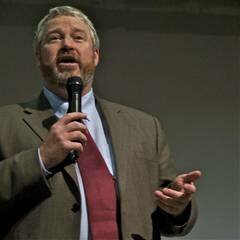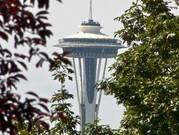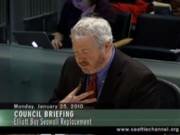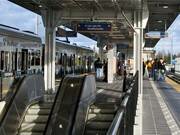 Moments later, Santa was pulled into the cage and nearly killed.
Moments later, Santa was pulled into the cage and nearly killed.
Ed. note: This story was originally posted last year on Seattlest and I'm bringing it back this year in the hopes it will become a treasured holiday tradition. Rest in peace, smelly cat.
When I looked down and saw the small pool of copper brown gel on the soft white cuff of my Santa uniform, the scent that had been offending me for nearly half an hour was suddenly made very clear. Just to be sure, I brought the sleeve to within an inch of my nose for a little sniff. Yes, there it was--a decidedly potent Preparation H-like substance that must have come from the small, terrified dog I'd met earlier who would have nothing to do with me. As the dog had struggled and pushed away, kicking violently at my ribs with its pointed little feet, it had slimed Santa with its anal gel.
After washing the cuff with soap and warm water, I could still smell the offensive odor. A further examination presented yet another smear of the brown slick mingling among the coarse white hairs of my beard, mere inches from my mouth. Luckily for me, a back-up beard waited in the employee lounge. Does this happen often? I wondered. Clean and newly bearded, I walked back to my post at the front of the store, thinking to myself that however sorry I felt for the little dog and its apparent discomfort, I thoroughly hated the human who'd set its exposed, hemorrhoid gel-covered anus in my arms.
During lulls in the photo-taking, I would occasionally walk outside for fresh air and wave at people at random. I would also wander the aisles of the store, often catching people off guard. I found it amusing to imagine someone suddenly seeing Santa in the corner of their eye, flipping through a book regarding the proper care of ferrets. It was during these expeditions that I made an interesting observation. Often, adult men would give me an accusing look as if to say, "Just who the hell do you think you are?" Women, however, would almost always smile and say, "Hi Santa," thereby proving my theory that all women want to sleep with Santa, which, comforted by this knowledge, is how I made it through two long days dressed as him....
Yesterday morning on my way to the office, I bicycled past a man who was shouting to someone from the sidewalk. "MA MEENY MA MOSEY!" he yelled, repeatedly, spittle flying. His eyes were fixed somewhere in the middle distance, his face was red with rage, and the object of his anger was invisible to me.
Depending on who you are, and the time of day, this is the kind of sight--after Shannon Harps--that usually reminds you that there's a good reason to walk a block out of your way. Stretch the legs.
I have felt that I've been seeing more and more homeless, mentally ill people in the grip of visible psychosis since the recession started, and I called Amnon Shoenfeld, director of the King County Mental Health, Chemical Abuse and Dependency Services Division, to see if this was purely anecdotal or not.
Shoenfeld has been director for the past seven years, and with the County in various capacities for 30. He earned his MSW from the University of Washington, and went to work for King County as a crisis outreach and involuntary commitment specialist in 1979.
There are about 27,000 people who rely (voluntarily or not) on King County's mental health services, and another 12,000 who are involved in substance abuse services. This number hasn't varied much recently, Shoenfeld said, but recent budget cuts at the state level have reduced funding by $7 million for mental health, and $3 million for substance abuse.
Funding cuts are about to worsen: Governor Gregoire has just released a doomsday balanced budget that would eliminate the Basic Health Plan and GAU (assistance for people unemployable because of mental or physical disabilities), slash financial aid for college students, and suspend "all-day" kindergarten and support for poorer school districts.
The Seattle Times notes that, "Most of the state budget is off-limits to cuts because it's either protected by the state constitution (such as funding for basic education) or by other requirements (such as the state's share of Medicaid, a federal-state insurance program for the poor.)"
"If I could say anything right now, I'd just say: Please don't cut us any more," Shoenfeld said near the end of our conversation.
I had asked him, looking for a bright spot, if extra funding was somehow found, where he would like it to go. But Shoenfeld, beleaguered, thinking of his case managers with up to 70 clients, couldn't go there at first.
Despite the fact that much of the mental health and substance abuse "bill" is associated with Medicaid, with the federal government footing as much as 60 percent, the state is perversely focused on what it is permitted to cut, rather than the overall cost-effectiveness of combined federal and state dollars.
"We had to cut back on outreach to kids--mainly street kids--who are abusing substances." As in so many cases, prevention is the cheapest option, Shoenfeld explained, but it seems less critical to the budget-cutting eye.
"We've had to cut back on the number of people who can get into outpatient treatment, both adults and kids. In King County, we have to use all our 'non-Medicaid dollars' to cover crisis services and involuntary commitment services, our evaluation-and-treatment programs, our residential programs," said Shoenfeld.
Now he's expecting proposed cuts of over $1 million in those core crisis services, which for the general public, is related to the sense of insecurity you feel at noticing more people ranting and raving, and behaving unpredictably....
November is a strange time to visit our large cousin to the north. It's cold, but there's very little snow. Every new day loses another five minutes of daylight from the previous. The whales have gone south. The bears have had their fill of salmon and are working on making their dens nice and cozy for the winter slumber. You can count the number of actual vacationers on one hand. Most of the out-of-towners appear to be there on business, as was the case with my wife. I tagged along because I can't pass up an opportunity to go to Alaska no matter what time of year it is.
We spent our first few days in downtown Anchorage without a vehicle. We stayed at a bed and breakfast called the Copper Whale at the West end and spent most of our time walking the streets, ducking into shops, boutiques, cafes, and brewpubs. There was a lot of bundling up, covering the ears, neck, and hands, only to shed it all again minutes later.
The high temperature during our stay was 35 degrees, though at times it was much colder than that. Still, I felt kind of silly, wrapped up as I was inside my snowboarding parka while hardened locals strolled by in little more than a flannel shirt. I told my wife I was glad it was so cold. "It makes the trip seem more exotic," I said. Luckily for us, the sky was clear, even sunny, so we were able to keep an eye on the surrounding mountains to be sure they were not misbehaving.
If you visit Anchorage, I recommend you not leave until you've consumed the following: the Crabby Omelet from Snow City Cafe, the Big Orso Burger from Orso, beers from Glacier Brewhouse and Snow Goose Restaurant and Brewery, and trivia night at Humpy's Great Alaskan Alehouse.
After a few days in Anchorage it was time to drive south to the Kenai Peninsula in a rented mid-size SUV. This is a breathtaking drive. First one must drive around the Turnagain Arm, a large inlet ringed by snow-capped peaks which seem to launch straight up from the icy water. The highway then ducks into the mountains and snakes its way through the gorgeous Chugach National Forest. The road then nuzzles the turquoise glacial waters of Kenai Lake and the Kenai River before eventually straightening out into a more even landscape dotted by marshes and small lakes.
Moose love Kenai. I don't think a day passed without seeing one of these huge, goofy-looking things in someone's lawn, on the side of the road, or, as was the case once, crossing the road right in front of me. I'm happy to report that the brakes worked wonderfully in my rented Toyota.
Located at the south end of the peninsula is the beautiful town of Homer. If you believe the bumper stickers popular in the area, Homer is "a quaint little drinking village with a fishing problem." If you ever get the chance to visit the area, you must visit Homer. It is stunning. And it has a spit.
As my wife was busy working for two days, that left me with a vehicle, some magnificent country, and ample time for exploration.
I drove around the first day, somewhat aimlessly, without an agenda or a destination in mind. I took photos, watched the sun rise over the Kasilof River, visited an old Orthodox Russion Church in the town of Kenai, and then drove around some more. Feeling like I must be missing something, I decided that my second day of solo exploration needed to be a little more organized....
 The rusting husk of Gasworks Park, a fitting metaphor for our elected government. Photo by our Flickr pool contributor feekner.
The rusting husk of Gasworks Park, a fitting metaphor for our elected government. Photo by our Flickr pool contributor feekner.
Late last month, I wrote about Oregon's special vote for Measures 66 and 67, two bills passed by the legislature and signed by the governor that were sent to the voters as a referendum, which raised taxes to help close a budget shortfall. One raised the minimum corporate tax for the first time since 1931, while the other was a modest increase in the income tax for high-earners (Oregon has an income tax but no sales tax). Both measures passed with substantial margins, with roughly 54 percent in favor to 46 percent opposed.
The vote was closely watched nationally because Oregon, like Washington, is a state known for its anti-tax fervor. Oregon had its own Tim Eyman, has caps on property tax increases, and has repeatedly rejected new tax increases. But faced with dramatic cuts to crucial services, Oregon voters banded together with their elected representatives and passed two very simple measures that kept the state working.
Our fearless leaders in Olympia, on the other hand, have done virtually nothing. While Gregoire has stated she wants to "buy back" some of the slash-and-burn budget cuts she originally proposed (as a matter of state law, which requires her to present a balanced budget--from the beginning, she made clear she did not support that budget), her alternate budget still relies extensively on cuts, with a large portion of new revenue expected from federal stimulus money. The House has introduced a bill (HB 3176) that would generate $210 million in new tax revenues by mostly closing loopholes, but that's a pittance compared to the overall $2.6 billion shortfall over the biennium....
 Trees at risk: each year, 200,000 trees just like the ones in this grove, go to the blade for junk mail.
Trees at risk: each year, 200,000 trees just like the ones in this grove, go to the blade for junk mail.
When the U.S. Congress passed the National-Do-Not-Call-Registry into law in 2003, and improved it in 2007, it became one of the most popular government programs in our nation's history. Almost overnight, the Registry stopped millions of obnoxious calls from interrupting the average American's dinner or Saturday morning sleep-ins. It wiped out the most intrusive, unwanted, and annoying communications development since Alexander Graham Bell implored Watson to "Come here, I want to see you."
I say nearly, because the DNCR left a few loopholes that continue to annoy us all. Exemptions for non-profit organizations and political calls continue to be allowed. This is a problem, but make no mistake: The Registry has been a stunning success that's allowed many of us the chance to eat our meals in peace.
Now the Seattle City Council has the chance to right a litany of wrongs when they vote on a resolution to petition the state legislature to ban junk mail. The council will vote for the resolution to create a Do-Not-Mail-Registry on January 11.
I could reel off a massive list of environmental reasons it's a good idea. The appropriately, and somewhat humorously-named group ForestEthics sent around a blast email to local media chock full of the "environmental impacts" of the local junk mail trade. For the ultimate guilt trip, consider these factoids:
- Almost 200,000 trees are cut for Seattle's junk mail every year
- Junk mail sent to Seatteites causes global warming gases equal to almost 6,000 cars, due to logging and industrial emissions
- It costs more than $400,000 a year to dispose of Seattle's junk mail.
That cleanup total, by the way, is paid by us through taxes. So every day my wife pulls the junk mail out of the mailbox and throws it into the recycle bin in one deft move, it's costing us money....
When the Seattle mayoral election was finally decided last night, after King County Elections dutifully counted up the votes, Joe Mallahan graciously conceded, and Governor Gregoire announced she was looking forward to working with the new mayor.
It sounded like business as usual, but Mike McGinn’s election was the biggest upset victory in Seattle politics in more than three decades. This was the 1980 U.S. hockey team over the Soviets, Truman over Dewey, David versus Goliath. It was an epic long shot and it shakes Seattle politics to its very core.
Seattle is no Chicago, but we have our own version of the political machine. Business, plus labor, plus the Democratic Party equals victory.
Mallahan won endorsements from state Democrats, the Governor, the Seattle Chamber of Commerce and its political arm the Alki Foundation, big business and labor. McGinn won the election.
Mallahan outspent McGinn by a 3.5-to-1 margin. Mallahan loaned his own campaign about as much as McGinn received in total. McGinn won the election.
Now, Seattle’s traditional powers-that-be are scrambling to figure out just how it all happened. All the money, all the powerbrokers, and all the political muscle didn’t deliver the knockout punch. There are all sorts of theories.
McGinn was helped by Mallahan’s complete ineffectiveness in debates. Mallahan struggled to get two thoughts together in a coherent fashion. In nearly every debate, he bobbled the easiest questions and completely missed on the major issues. The fact that McGinn’s lead increased as the counting went on suggests that the late voters broke for him, not Mallahan. Seems the longer Joe talked, the less people liked what they heard.
McGinn won the election just the way he said he did, by talking to people and by listening to people. He won by energizing his supporters with a message of common sense and a determination to fight for change....
*Ahem* The world of blogging is full of tiny little accomplishments. QUIET IN THE BACK! Thank you.
When, following what I am now realizing must have been an undiagnosed stroke, I decided to launch a Seattle news and culture blog, I was thinking primarily of beer money. When I gathered this hardy band of ex-Seattlest-ers, I looked them each in the eye and said, "We will make enough money for a monthly happy hour."
As God is my witness.
Not only did I want us to be writing about local news and people and events, but I wanted to give local businesses and arts groups and politicos a way to reach Seattle readers for what amounts to beer money. Now, I won't lie, we're not talking PBR. I have a fondness for Old Seattle Lager. For the German imports.
But it's working. On our second day, Central Cinema ads showed up. I didn't think it was possible to love a place more that brings me pizza and beer while I watch a movie, but it was. And then Scarecrow Video asked about rates. They're both an advertiser and a source--when I was doing a post about SIFF's Spanish film fest, Scarecrow gave me a list of even more new Spanish films for you to watch. And now Richard Conlin--there he is, in the sidebar, elect him--from the City Council has piled on. Endorsed by The Stranger and the Seattle Times. He's got my vote for that accomplishment alone.
I know, it's only three advertisers. But they couldn't be more local. I--excuse me, a bit choked up...I wrote at Seattlest for four years and all we got was a Chris Gregoire ad. So this is a real moment for me. Big hug, Seattle. Big hug.
Regular readers of The SunBreak are aware that a friend of mine had a traumatic roll-of-quarters experience with the Chase branch in the University District, back in November:
He stopped by the branch in the University Village to pick up a roll of quarters because he's paranoid about using his credit card in parking meters. He bought a roll for ten dollars, stepped outside to open up the roll, and discovered that he'd also bought a number of dimes, nickels, pennies, and Phillipine centavos.
As it happened, this week brought a return visit to the same branch (via drive-thru) for quarters. The teller proffered (via the drive-thru transport device) one of the self-packed rolls that customers bring in, and my friend, remembering his last experience, balked.
"Can you open it?" he asked. Behind the window, the teller gave him a look that translated as, "Um--no!" He explained that he only asked because of the last time with the centavos. "The last time, you guys said if I left with the quarters, it was my responsibility." The teller agreed it was. "Can I just get one of the machine-filled rolls?" The teller was disinclined to acquiesce....
 (via TechFlash) All over the Pacific Northwest this morning, PR professionals glanced through the New York Times and thought, "Hey, Microsoft got a hit!" Then they realized that a hit had been done on Microsoft and they prepared for a round of stomach-churning conference calls.
(via TechFlash) All over the Pacific Northwest this morning, PR professionals glanced through the New York Times and thought, "Hey, Microsoft got a hit!" Then they realized that a hit had been done on Microsoft and they prepared for a round of stomach-churning conference calls.
Dick Brass, a VP with Microsoft for seven years, until 2004, wrote this about his former employer:
The problem comes when the competition becomes uncontrolled and destructive. At Microsoft, it has created a dysfunctional corporate culture in which the big established groups are allowed to prey upon emerging teams, belittle their efforts, compete unfairly against them for resources, and over time hector them out of existence. It's not an accident that almost all the executives in charge of Microsoft's music, e-books, phone, online, search, and tablet efforts over the past decade have left.
Apologists will have plenty of countercharges to make against Brass or his claims, but this element of Microsoft's culture is well known, and remonstrating with people who mention it is just evidence of Microsoft's inability to see and critique its behavior....
I admit it took me a deep-breathing exercise to get through Bill Gates's roundtable on measuring innovation. It's because of this stinger at the end, from the world's wealthiest man:
So when people say middle class salaries have not gone up much I think that the “basket of goods” approach to measuring improvement inherently understates how much better life is now than it was in the past.
It's not that he's not correct, but there's equity and there's "better." When you talk about quality of life improvements, you're often talking about things that a society shares (or tries to share) access to. Bill Gates uses the internet; so does the homeless person at the library. But: income inequality in the U.S. hasn't been this great since the Great Depression. I worry about the blinkered effect of this kind of thinking.
Still, it's an intriguing question, how to measure what innovation brings to the table, because as Gates instances, innovation often makes something inexpensive. We're not good at seeing the removal of costs as a benefit. (Just like Microsoft can't seem to get their heads around the removal of bloat.)...
Part of the ammunition Mayor Mike McGinn brought to his City Council briefing on the seawall replacement [video] were the results of a poll he had conducted on the public's willingness to fund it. Of the 1,001 people who were asked this question:
This May, voters will decide a property tax measure to fund replacement and seismic improvements to the downtown seawall, built by city engineers in 1934. The measure authorizes property taxes of up to two hundred forty one million over thirty years, at approximately twelve cents per thousand dollars of assessed valuation.
If the election were today, would you vote yes to approve, or no to reject this excess levy?
70 percent said yes, 19 percent said no, and eleven percent were undecided. The margin of error is plus/minus three percent. That 70 percent is important because the property measure that McGinn is proposing requires a 60 percent approval rating. At $0.12 per $1,000 of property value, it would raise $241 million.
McGinn argued to the Council that the response to "What's the hurry?" is not just public safety, but is related to the depleted city coffers as well. In a letter, McGinn wrote:
Until further funding is secured, financial constraints will limit design and permit work. In 2010, $8.3 million was appropriated for design and permit work. While it is difficult to estimate the precise cash flow impact of accelerating the seawall project, SDOT estimates that an additional $3 million will be needed to cover the additional design and environmental review for 2010....
(more)
Visiting family in Portland over the weekend, I got to witness firsthand the difference between how Oregon and Washington are handling their budget crises in the midst of a recession. On Tuesday, Jan. 26, Oregon voters look set to approve ballot Measures 66 and 67, reasonable tax increases on wealthy individuals and businesses, to help fund their budget shortfall and support crucial public services.
Measure 66 raises the state income tax (Oregon has an income tax but no sales tax) 1.8 percent on individuals making over $125,000, and households making over $250,000. The measure also lowers taxes on the unemployed by exempting the first $2,400 of unemployment benefits. Measure 67 raises the minimum business tax for the first time since 1931, from $10 to $150, and adds a 1.3 percent tax on corporate profits over $250,000. The measures are public referendums on bills passed by the legislature last year, and pollsters show both passing....
Some people have internet stardom thrust upon them, and such was the case of Elizabeth Becton, the newly ex-executive assistant to Rep. Jim McDermott (D-Fightin' 7th). Politico reports Becton has left the office (along with chief of staff Mike DeCesare). Her infamous "Don't call me Liz" email thread, the Keith Olbermann reenactment of which was #1 in the list of the most outrageous political videos of 2009, was actually just a highlight from a storied email-invective past, according to Wonkette. She'll always have her Facebook fan page, of course. And we'll always have the eye-singing memories.
In a Crosscut story on Mayor McGinn's surprise seawall announcement last week, former mayor Charles Royer said, "I believe him when he says it is a security and safety issue, because that is what the engineers were telling me in 1985." A 2003 civil engineering paper backs Royer up, saying that the need for a new seawall has been known "for twenty years."
But since the Nisqually earthquake in 2001, seawall repair was moved from the back burner, if not exactly to the front burner. In the November 8, 1934, Engineering News Record, which looked into construction of the first seawall, several challenges were detailed: "the high cost entailed by the physical problems of soft bottom, and a 16-ft tide range, with the attendant marine-borer menace to timber construction." These naturally resurfaced with the prospect of repair.
But then as now, you can't engineer politics. So nine years later, when the Mayor suggests moving seawall construction up by two years, you can read this response on City Council member's Tim Burgess's blog: "Elliott Bay Seawall: Questions to Ponder." What you will learn is that nine years after city leadership was confronted with a significant chance of catastrophic failure of the seawall:
- We don't know what it will cost or look like,
- don't know who will pay for it,
- and don't have a construction process mapped out....
(more)
Ever have one of those dreams where you go through your everyday routine only to find out that you've forgotten to put pants on? Sunday afternoon, a couple hundred people made their dreams a reality by participating in Emerald City Improv's No Pants Light Rail Ride.
The instructions for the afternoon ride were easy. Meet at Westlake at noon. Get on the light rail. Take your pants off. Pretend like everything is normal. Go to the airport. Have fun. Ride back to Westlake. Go home and hope your co-workers won't find the pictures of you that show up on the internet. Reminisce.
After overcoming their fear of public pantlessness, people took the ride with varying degrees of seriousness and silliness. Several gentlemen were dressed in business suits and nice shoes. A few groups of people pretended they were just going to catch a plane. It seemed that everyone was dropping books or change on the platforms and bending over really slowly to pick it up. The rest of the participants were taking pictures, reading books, drinking coffee, or talking on their phone, just like a regular train ride in any other city, except from the waist down.
In Seattle, we've only had this particular train for a couple months. Ridership has been expected to rise with the opening of the new airport station. Sunday might have been a bit of a boost to those numbers. In the car I rode in, there were approximately 34 people. 30 of those people lacked what one might call "pants."...
A coyote has been haunting Magnolia for a few months, and this morning it was Charles Redell's turn for a sighting. Out walking his dog, he didn't notice the coyote until it was about 40 feet away.
I started yelling and all the coyote did was stand there and stare. My dog was now freaking out so I started to back away and the coyote started following us. Talk about terrifying!
Charles shouted, and chucked a tin can at the animal to no effect. Finally he found a large rock to heave. The coyote bolted, he said, at the sight of a crazy man about to stone it.
The Seattle Times talked with the Department of Fish and Wildlife's "problem wildlife coordinator" Sean Carrell and learned that "It's rare for coyotes to attack pets or people, but it does happen, said Carrell. He advises feeding pets inside, not letting them stray, and if a coyote is seen, making loud, threatening noises to frighten it away."
The Magnolia Voice has been covering the itinerant coyote's wanderings, and has a number of pictures. It's a little troubling that the animal isn't responding to verbal threats, only the threat of actual violence. Says Charles:
I'll tell you that unlike most coyotes I've seen in pictures/documentaries, this one looked pretty good--though it is the first I've seen live. It was thin, to be sure, but not scrawny by any means. Svelte is the word I would use. It was tall, too. Much taller than a dog. There was absolutely no way it could be mistaken for a stray dog or anything even though its coat did not look scraggly in the least. Its eyes were very dark and very keen. It is a beautiful animal and was not scared of me and my antics in the least.
For those of you--and I know you're out there--who believe the University of Washington manufactures strictly socialists by the bushel, consider the case of Dale Robertson, a man unafraid to appear in public with a sign that reads "Congress = Slave owner, Taxpayer = Niggar."
Wonkette is having a field day with this photo from last year. If nothing else, it demands much more introspection from a man who talks about helping the politically blind see and the deaf, hear.
Robertson, a veteran of the Marines and Navy, with 22 years of service under his belt, got his bachelor's degree in Political Science at the UW. He owns the site Teaparty.org, where he documents his role in the movement's genesis ("Much like Tiananmen Square, Dale stood alone representing the American people"). His political science degree is his second; he earned a degree in engineering at Southwest College, in San Diego.
I don't know Dale Robertson, but I'd like the chance to tell him in person that this sign is not doing his cause any good. It's (highly) offensive to many people, even if you take it in the best possible, in-solidarity light, which is hard to square with Robertson's oft-professed, uncritical faith in the Founders' intent. (Plenty of slave owners worked on the Constitution.) People keep trying to weasel by with this kind of thing, and I prefer my racists bold and proud, so I know where they stand.
It also would be difficult, not to say naive, to take it in the best possible light given the Tea Party's nationally televised animus toward our Commander in Chief. This year, they are planning a "national strike" on Inauguration Day. Perhaps never before has Black History Month seemed so timely.
 Ex-Green Beret Michael Yon has been making a good living as an independent war correspondent, blogging his way through Iraq and Afghanistan, for some years now. He's been in the New York Times and the Wall Street Journal, on CNN and FOX News.
Ex-Green Beret Michael Yon has been making a good living as an independent war correspondent, blogging his way through Iraq and Afghanistan, for some years now. He's been in the New York Times and the Wall Street Journal, on CNN and FOX News.
But when he refused to tell "border bullies" (customs officials? TSA?) at the SeaTac airport how much money he made, they handcuffed him. He was eventually "rescued" by Port of Seattle police. "No country has ever treated me so badly," he added in another Facebook update, and included Afghanistan and Singapore in that list.
Airport security is understandably tight at the moment, following the Christmas Day failure to prevent a bomber from boarding not one but two flights. But it's difficult to see what self-reported income would add to airport security. And I'm not aware of any rules stating that U.S. citizens have to declare their income before being readmitted to the country.
Hey, welcome to Seattle, Michael!
Perry Lorenzo, known to thousands as Seattle Opera's education director, died over the weekend, succumbing to lung cancer. He was 51.
Perry joined the Opera in 1992, after ten years at Burien's Kennedy High School. Very quickly, he transformed the education department: His standing-room-only preview lectures became a sold-out $5 ticket, and helped fund the beginnings of a Young Artists Program, which over the years has become one of the country's leading opera training programs.
His popularity as a lecturer on opera never waned, and he traveled far and wide to share his enthusiasm for the art form, to San Francisco and New York, and even to Bayreuth's Ring festival, as a representative of the world's other great Wagner town.
Now let me take a moment to remember Perry personally. We met in or around the B&O Café on Capitol Hill in 1991, through a fellow classmate of mine from Seattle University. (Perry often spoke and taught at Seattle U.) He was still teaching at Kennedy H.S. at the time, and when he learned I was working at Seattle U.'s writing center, he talked me into giving feedback on his AP students' papers.
"They think they are ready for college," he told me, "so let them know the bar will be higher." I tried to be diligent. After the first pass, he asked me, graciously, not to make his students cry. Occasionally they popped into the B&O to say hello to their favorite teacher, and he took great pleasure in introducing me as the person who wrote all those critical comments on their papers.
Perry arranged my first real editorial job out of college, vouching for me when a temporary position came open at the Opera, and I got a trial stint as managing editor of the Opera's magazine and programs. I ended up spending most of the 1990s at the Opera, and watched firsthand as Perry tirelessly voyaged first around Seattle, then the Puget Sound, then the state, always leaving new opera fans in his wake.
An immensely funny, intelligent, and sensitive man, in public he adopted a hortatory mood. Yes you can, he insisted to audiences restive with high art apprehension, not simply understand, but know the appeal of opera. A staunch Catholic, he loved the rituals and ceremony of opera as much, I think, as the art of it....
The following is from an email sent by ASUW President Tim Mensing to UW students that was forwarded to me this morning. The juxtaposition of the standard end-of-term best wishes and the attempt to put the fear of the financial gods into students is sort of funny, in that not-at-all funny way. Just another sign that our little economic hiccup is far from over, and the State's budget nightmare is hitting everyone. All formatting is as in the original.
From: ASUW President Tim Mensing
Date: December 17, 2009 10:59:54 PST
Subject: Final
Hello all,
First of all, I wish all of you the best on finals, and hope that your Autumn quarter was a success both in class and in life. Over the break I hope you'll have time to relax and recharge. Read below for info that effects you.
**Important**
If you have not already done so, please fill out this survey about the "least bad options" to address decreased state funding for higher education: [available only to UW students]. This survey is certainly simplistic, as few decisions are as basic as "Quality" versus "Cost." Nonetheless, your input and comments will help guide the University through some difficult decisions in the future. The survey will close at 5pm on Friday, December 18th.
***
As you have probably heard in the proposed state budget for next year, financial aid will be halved. As an example for what this means, if you're a Husky Promise student this year, you quite possibly won't be one next year. State legislators vote for what their constituents want, so please, engage your parents with this issue, and join the ASUW Political Action Network.
We understand everyone is facing cuts, but right now what we need in our legislature is an understanding of the importance of higher education, and the willingness and courage to seek smart ways of revenue generation to combat this crisis. There is a better option out there.
Finally, now, more than ever, as students we must look out for one another. In response to this need a scholarship program called the Husky Pride Fund was created. Please join the facebook fan page to show your support.
As of 10 a.m. on Saturday, December 19, there will be a SeaTac light rail station open for business. For $2.50 (one-way), you can ride the full line from the Westlake station downtown to the airport, and the Central Link segment will be complete.
It's only a three-minute jaunt from the Tukwila station, where the line used to end, to the airport station, but it cost $268 million. (The whole trip from downtown takes about 36 minutes, and trains run every 7.5 to 15 minutes, depending on the time of day.) Besides its ahead-of-schedule opening--which was originally set for December 31--the airport station has come in under budget.
The Port of Seattle handed me a fact sheet on a media preview walk-through this morning, noting proudly that the road improvements associated with the station construction cost $10 million less than budgeted in Port funds, and the pedestrian bridge and walkway came in at $1.4 million less. Altogether it's 950 feet from the platform to the first terminal skybridge, which everyone is sensitive about.
You can arrange free wheelchair service from Huntleigh (call in advance 206-433-5287), but otherwise you're hoofing it. There will be baggage carts, but nothing for you to ride on. (A people-mover was ruled out because of logistical considerations--it wouldn't really fit--and extra expense.) You won't notice the length so much on your way in; it's the return trip, when you've already hiked a few miles through airports, that the extra quarter-mile will wear on you. Still, for transit riders, a hike was already in order to get to the bus stop south of the terminal.
The Port's SeaTac employees, interestingly, may provide a good deal of the light rail regular ridership. Some 22,000 people commute to work at the airport each day, and it's hoped that some will take the new train, in addition to travelers. I'm checking with the Port on how it currently encourages its employees to take transit, and if there will be a special light rail push.
UPDATE: Perry Cooper, the Port's media officer, says via email:
We can’t predict how many employees will move to riding light rail, but we have several Commute Trip Reduction qualified employers, including the Port, Alaska Air Group, Delta and Host (who run many of our concessionaires). Another one of the largest employee groups that may take advantage of light rail are the employees of TSA, who have a significant number of employees that utilize public transportation.
For the Port’s Aviation division here at Sea-Tac, we have approximately 280 employees that hold a FlexPass, which is good on King County Metro, Pierce County Transit and Sound Transit including the Link Light Rail. We continue to promote that throughout Port employees.
 For more than a decade, Seattle has prided itself on its robust economy and unmatched blend of innovative, successful companies. We’ve had it all. So it’s particularly hard to see a local, homemade Seattle company get whacked and weakened by punch after punch from its competitors.
For more than a decade, Seattle has prided itself on its robust economy and unmatched blend of innovative, successful companies. We’ve had it all. So it’s particularly hard to see a local, homemade Seattle company get whacked and weakened by punch after punch from its competitors.
Starbucks [SBUX] is having a rough recession. They’ve had to close hundreds of stores due to declining sales and have seen their market share shrunk by the likes of McDonald’s and Dunkin’ Donuts.
Today, they’ve taken another smack to the gut from the boys behind the Golden Arches. Starting in January, McDonald’s will be offering free Wi-Fi. What this means is that the company behind the guy in the clown outfit has out flanked Starbucks yet again and gone directly to consumers with something they want and, frankly, demand.
For years Starbucks has stubbornly stuck to the notion that people like their stores and products so much that they will pay for an Internet connection they can find for free at a local café down the street (or now at a fast food chain with much cheaper lattés). In all fairness, Starbucks does offer free Wi-Fi, but only to AT&T Internet subscribers, or if you have a Starbucks card--otherwise, you pay for your time.
This might have made sense four years ago when wireless Internet first made its move towards ubiquity. But the world has changed and customers demand access as a prerequisite for settling down with a hot cup of Joe.
Everyone else, it seems, has recognized that having people stay in your store and probably buy more than one drink, a donut, juice, or a Happy Meal is a very good thing. They probably realize that the income they generate from those incremental sales will pay for the cost the store incurs from an Internet connection.
The bitter irony, pun intended, is that Starbucks invented the concept of the coffee-house-as-office. They created the idea of a comfortable, cozy place to have an espresso and get a little something done. One could argue that the rapid rise of 3G phones is a direct response to people wanting tools that would allow them to be productive while sitting in someplace very much like Starbucks. ...
So I'm sitting in the Elliott Bay Café in Pioneer Square, interviewing Vittana co-founder Brett Witt (hobbies: iPhone hacks, djing) and their international partnerships guy Nick Cain (skateboarding, water polo).
In quick succession we hit on Amazon's personalization (though Witt and CEO Kushal Chakrabarti don't work on Bezos' farm no more), Seattle's microfinance start-up scene (not to mention heavy hitters like Grameen, Unitus, Global Partnerships, too), and social media--and I realize I am scribbling this all down in a $1.29 notebook I got from Walgreen's.
Bloggers invented microfinance!
Actually, no, we did not. Neither did Muhammad Yunus, but the founder of Grameen Bank did a lot to prove that microcredit works--that right-sized lending creates a huge pool of potential investors and gives micro-entrepreneurs a chance to take financial risks that won't crush them.
With the nonprofit Vittana (they're also on Facebook), Kushal and Brett are taking microfinance in a new direction: college loans. Up to now, microlending has focused on the benefits of lending small amounts over short time frames. College loans are (someone has to say it) microfinance 2.0. That's why, I imagine, Huffington Post readers picked Vittana as the " Ultimate Game Changer in Philanthropy." (1.7 million votes were cast in ten "Game Changer" categories.)
A recent New York Times profile of Vittana summarizes the stumbling block: "Mainstream banks and others lend to microfinance institutions who in turn lend to small entrepreneurs because those loans support an activity that generates income. But a loan to a college student bears no immediate promise of repayment."
Especially in developing countries, the concept of government-funded student loans has yet to take hold, and prospective students are faced with the familiar Catch-22 of borrowers the world over: You have to be well-off to qualify for a loan.
The Times quotes Timothy Ogden, publisher of Philanthropy Action, to get to the real game-changing part: "If you’re trying to raise standards of living, making an education loan is probably a better way of doing that than lending another $100 to an illiterate and unskilled woman to open another roadside stand."
"We just want to show that this is a feasible idea--a probable idea," says Brett, who's from Chicago's West Side, dredded, and brought you your Amazon Watch List. "One of our biggest 'products' or contributions to the field is just figuring out how student loans work [with a microfinance model]."
So far, Vittana has provided students with 33 loans worth $37,000 altogether, to students in urban areas of Paraguay, Nicaragua, Peru, and Mongolia. Vietnam and Cambodia are just coming online.
Right now, the average loan amount is just over $1,000, but "historically" (the site launched in May 2009), loans have ranged from $500 to $800. After their HuffPo fame broke, the number of lenders has doubled, which is good news because the number of students they put up on the site is tied to the lending resources available. Vittana lenders get their money back (in fact, there have been no defaults at all so far), but the loan is provided on an interest-free basis. All the cash transfers happen via PayPal....
AccuWeather claims it's 33 degrees right now, but it doesn't feel like it. A quick tour of Capitol Hill water features confirms that below freezing is the order of the day. Here are some Red Cross safety tips, while I'm at it, on dealing with frozen pipes. Cliff Mass says last night might have been the coldest night of the whole winter, for many. Seattle's severe weather shelters are open for business.
Hello!
We're on Twitter: @thesunbreak.
We're on Facebook.
![]() Subscribe to all SunBreak Stories
Subscribe to all SunBreak Stories
Most Viewed Stories
Recently in Our Flickr Photo Pool
www.flickr.com
|









Most Recent Comments